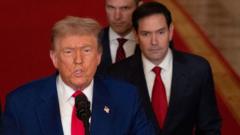**The Department of Government Efficiency, led by Elon Musk, asserts it has saved substantial taxpayer dollars since its inception; however, scrutiny reveals significant discrepancies and a lack of supporting evidence.**
**Elon Musk's Department of Government Efficiency: Fact or Fiction?**

**Elon Musk's Department of Government Efficiency: Fact or Fiction?**
**Analysing the claimed savings from the Doge initiative**
Elon Musk's Department of Government Efficiency (Doge) has gained attention for its claims of drastically reducing US government spending, reportedly saving over $10 billion weekly since President Trump took office. As of late April, these claims reached a total of about $160 billion, asserted vocally by Trump, who hinted at nearly $200 billion saved.
However, recent investigations into Doge's savings message reveal a troubling pattern of unsupported assertions. While Musk set an ambitious target to cut $2 trillion from government expenses, he later amended this to $150 billion by the fiscal year 2026. The credible evidence backing up these savings is sparse, with less than 40% of the total savings documented sufficiently for review.
Doge's website boasts a running tally of savings, but an in-depth evaluation showed that only half of the claimed savings had references to corroborating documents. Additionally, Doge has recently been caught miscalculating the value of contracts, mistakenly inflating savings claims by citing a $8 billion figure from a canceled immigration contract when the actual contract was valued at just $8 million.
Investigations into the largest savings claims reveal even larger discrepancies. For instance, one of Doge's prominent alleged savings stemmed from a canceled contract for a facility housing unaccompanied migrant children in Texas. Though the agency claimed a saving of $2.9 billion, sources familiar with the contract say the realistic savings due to early termination is closer to $153 million.
This pattern extends to other major claims presented by Doge. In a supposed cancellation of a contract with the IRS, the purported $1.9 billion saving raises eyebrows due to uncertainties around actual expenditures, with no funds reported spent despite the contract having officially existed. This raises the question of whether there were actual savings or merely projected future costs not incurred. Similarly, claims made around IT contracts and grants from USAID to health organizations lack verifiable evidence.
Overall, while Doge may have progressed with some cost-cutting initiatives, the team's lack of robust documents supporting its major claims calls into question the legitimacy of its reported savings. As the investigations continue, clarity around Doge’s efficacy in reducing government spending remains clouded by misreporting and inaccuracies.
However, recent investigations into Doge's savings message reveal a troubling pattern of unsupported assertions. While Musk set an ambitious target to cut $2 trillion from government expenses, he later amended this to $150 billion by the fiscal year 2026. The credible evidence backing up these savings is sparse, with less than 40% of the total savings documented sufficiently for review.
Doge's website boasts a running tally of savings, but an in-depth evaluation showed that only half of the claimed savings had references to corroborating documents. Additionally, Doge has recently been caught miscalculating the value of contracts, mistakenly inflating savings claims by citing a $8 billion figure from a canceled immigration contract when the actual contract was valued at just $8 million.
Investigations into the largest savings claims reveal even larger discrepancies. For instance, one of Doge's prominent alleged savings stemmed from a canceled contract for a facility housing unaccompanied migrant children in Texas. Though the agency claimed a saving of $2.9 billion, sources familiar with the contract say the realistic savings due to early termination is closer to $153 million.
This pattern extends to other major claims presented by Doge. In a supposed cancellation of a contract with the IRS, the purported $1.9 billion saving raises eyebrows due to uncertainties around actual expenditures, with no funds reported spent despite the contract having officially existed. This raises the question of whether there were actual savings or merely projected future costs not incurred. Similarly, claims made around IT contracts and grants from USAID to health organizations lack verifiable evidence.
Overall, while Doge may have progressed with some cost-cutting initiatives, the team's lack of robust documents supporting its major claims calls into question the legitimacy of its reported savings. As the investigations continue, clarity around Doge’s efficacy in reducing government spending remains clouded by misreporting and inaccuracies.





















